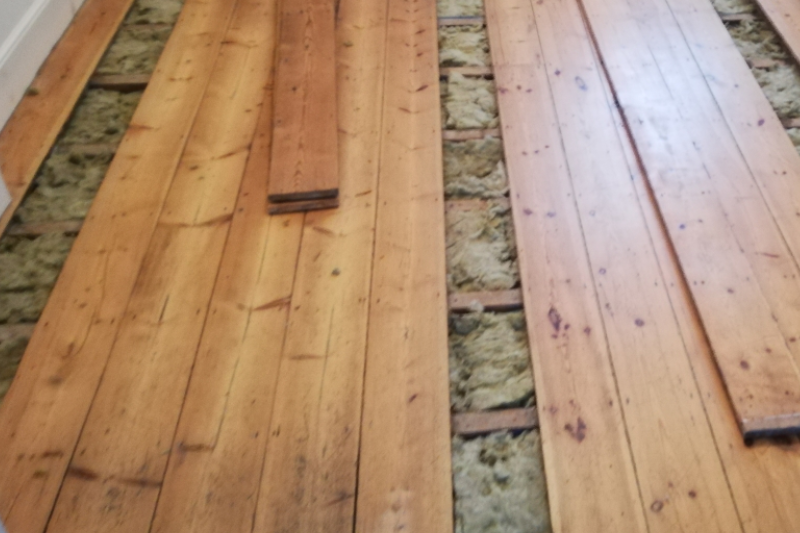- Home
- Scotland's changing climate
- Urban Housing in Scotland
- Maintenance
- Ventilation
- Airtightness
- Insulation
- Lofts - insulation at ceiling level
- Lofts - insulation at rafter level
- Cavity wall insulation
- Solid Walls: Internal vs External Insulation
- Internal Solid Wall Insulation (IWI)
- External Solid Wall Insulation (EWI)
- Timber frame retrofit
- Windows and doors
- Openings in 'historical' buildings
- Openings in 'non-historical' buildings
- Ground floors
- Suspended floors
- Suspended floors - from below
- Suspended floors - from above
- Solid floors
- Insulation materials
- Building science
- Space heating
- Solar energy
- Product Selector
Suspended Floor Insulation
Above or below?
With suspended floors, the big issue is whether or not you can insulate from beneath. Insulating from beneath is usually a lot easier (if there’s room), so you do not have to disrupt the room above or lift floorboards. However, the benefits of insulating from below start to evaporate as the space available gets tighter. If the solum depth is less than 600mm, then it might be easier to install from above.

Important to Know
• It is critical that adequate ventilation is retained beneath, or if not present, created within and across the solum. This ensures that joists are kept dry and free from the risk of decay or infestation.
• As with lofts, the aim is to get a layer of insulation without gaps, with air gaps sealed across and around the edges of the floor, and all services carefully managed.
Topic | Conventional Guidance | Our Guidance |
|---|---|---|
ENERGY | Insulate between joists; rigid boards give better U-values or roll type over the netting. | Emphasise the importance of floors generally. Insulate between joists; supplement above or below if necessary. No gaps. Use soft or ‘semi-rigid’ rolls |
HEALTH | - | Emphasise the importance of floors generally. Insulate between joists; supplement above or below if necessary. No gaps. Use soft or ‘semi-rigid’ rolls |
FABRIC | - | Measures noted for Energy, Health, Maintenance and Moisture will protect building fabric from long-term problems. |
MODELLING | - | As per Energy above – emphasis on airtightness and details generally. |
FABRIC | - | As per Energy above. |
MOISTURE | Ensure solum ventilation. | Solum ventilation removes moisture safely. Hygroscopic insulation helps protect timber. |
PEOPLE | - | Invest in upgrading services, etc., before installing insulation (less cost and disruption later)—guidance on Health & Safety issues concerning installation. |
CONSTRUCTION | - | Soft insulation works better between timbers. Hygroscopic material helps protect timber from moisture problems. |
MAINTENANCE | - | Review / upgrade existing joists and services before starting. |
SIGNIFICANCE | - | It is unlikely to be relevant, but protecting listed or otherwise significant floor finishes is important. |
Our Guidance vs Conventional Guidance
Probably the biggest difference between our guidance and conventional guidance is the importance we place on floors. After lofts, it is without doubt the next most important area to insulate for energy efficiency. This is not necessarily because the savings will be the next largest, but because the effort, cost and risks are relatively low in comparison with wall insulation, for example.
Use of a vapour-permeable membrane
Conventional guidance for suspended floors usually shows a net material to hold the insulation between joists. In contrast, we offer an airtight, vapour-permeable membrane which will prevent cold air ‘washing’ heat from the open surface of the insulation. We also emphasise the importance of sealing this membrane to the surrounding walls, and this is to reduce air leakage into the heated spaces above.
Soft or semi-rigid insulation
We also propose soft or semi-rigid insulation to ensure it forms a snug fit because this is likely to be more effective than using a ‘higher performance’ (lower lambda) rigid insulant with even small gaps around, and as elsewhere, we propose natural and hygroscopic materials which better protect the surrounding timber from moisture.